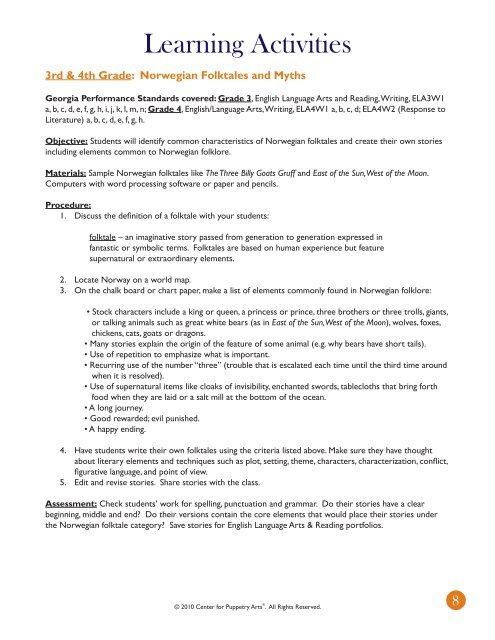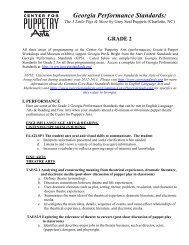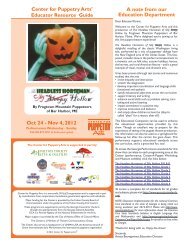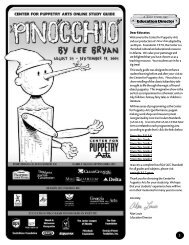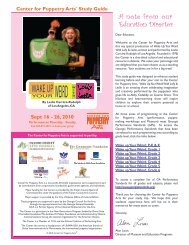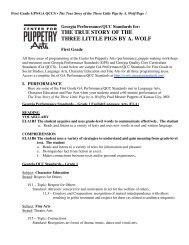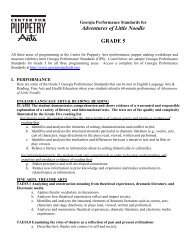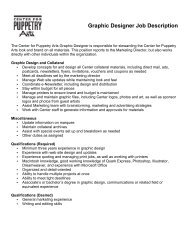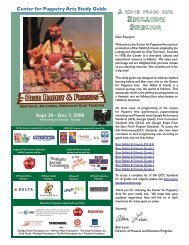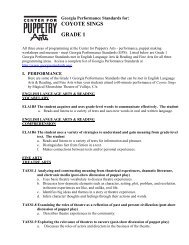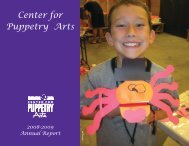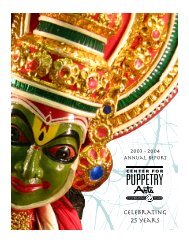Three Billy Goats Gruff and Other Tales - Center for Puppetry Arts
Three Billy Goats Gruff and Other Tales - Center for Puppetry Arts
Three Billy Goats Gruff and Other Tales - Center for Puppetry Arts
Create successful ePaper yourself
Turn your PDF publications into a flip-book with our unique Google optimized e-Paper software.
Learning Activities<br />
3rd & 4th Grade: Norwegian Folktales <strong>and</strong> Myths<br />
Georgia Per<strong>for</strong>mance St<strong>and</strong>ards covered: Grade 3, English Language <strong>Arts</strong> <strong>and</strong> Reading, Writing, ELA3W1<br />
a, b, c, d, e, f, g, h, i, j, k, l, m, n; Grade 4, English/Language <strong>Arts</strong>, Writing, ELA4W1 a, b, c, d; ELA4W2 (Response to<br />
Literature) a, b, c, d, e, f, g, h.<br />
Objective: Students will identify common characteristics of Norwegian folktales <strong>and</strong> create their own stories<br />
including elements common to Norwegian folklore.<br />
Materials: Sample Norwegian folktales like The <strong>Three</strong> <strong>Billy</strong> <strong>Goats</strong> <strong>Gruff</strong> <strong>and</strong> East of the Sun, West of the Moon.<br />
Computers with word processing software or paper <strong>and</strong> pencils.<br />
Procedure:<br />
1. Discuss the definition of a folktale with your students:<br />
folktale – an imaginative story passed from generation to generation expressed in<br />
fantastic or symbolic terms. Folktales are based on human experience but feature<br />
supernatural or extraordinary elements.<br />
2. Locate Norway on a world map.<br />
3. On the chalk board or chart paper, make a list of elements commonly found in Norwegian folklore:<br />
• Stock characters include a king or queen, a princess or prince, three brothers or three trolls, giants,<br />
or talking animals such as great white bears (as in East of the Sun, West of the Moon), wolves, foxes,<br />
chickens, cats, goats or dragons.<br />
• Many stories explain the origin of the feature of some animal (e.g. why bears have short tails).<br />
• Use of repetition to emphasize what is important.<br />
• Recurring use of the number “three” (trouble that is escalated each time until the third time around<br />
when it is resolved).<br />
• Use of supernatural items like cloaks of invisibility, enchanted swords, tablecloths that bring <strong>for</strong>th<br />
food when they are laid or a salt mill at the bottom of the ocean.<br />
• A long journey.<br />
• Good rewarded; evil punished.<br />
• A happy ending.<br />
4. Have students write their own folktales using the criteria listed above. Make sure they have thought<br />
about literary elements <strong>and</strong> techniques such as plot, setting, theme, characters, characterization, conflict,<br />
figurative language, <strong>and</strong> point of view.<br />
5. Edit <strong>and</strong> revise stories. Share stories with the class.<br />
Assessment: Check students’ work <strong>for</strong> spelling, punctuation <strong>and</strong> grammar. Do their stories have a clear<br />
beginning, middle <strong>and</strong> end? Do their versions contain the core elements that would place their stories under<br />
the Norwegian folktale category? Save stories <strong>for</strong> English Language <strong>Arts</strong> & Reading portfolios.<br />
© 2010 <strong>Center</strong> <strong>for</strong> <strong>Puppetry</strong> <strong>Arts</strong> ® . All Rights Reserved.<br />
8


